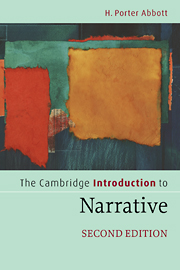Book contents
- Frontmatter
- Contents
- List of illustrations
- Preface
- Preface to the second edition
- Acknowledgments
- Chapter 1 Narrative and life
- Chapter 2 Defining narrative
- Chapter 3 The borders of narrative
- Chapter 4 The rhetoric of narrative
- Chapter 5 Closure
- Chapter 6 Narration
- Chapter 7 Interpreting narrative
- Chapter 8 Three ways to interpret narrative
- Chapter 9 Adaptation across media
- Chapter 10 Character and self in narrative
- Chapter 11 Narrative and truth
- Chapter 12 Narrative worlds
- Chapter 13 Narrative contestation
- Chapter 14 Narrative negotiation
- Notes
- Bibliography
- Glossary and topical index
- Index of authors and narratives
Chapter 8 - Three ways to interpret narrative
- Frontmatter
- Contents
- List of illustrations
- Preface
- Preface to the second edition
- Acknowledgments
- Chapter 1 Narrative and life
- Chapter 2 Defining narrative
- Chapter 3 The borders of narrative
- Chapter 4 The rhetoric of narrative
- Chapter 5 Closure
- Chapter 6 Narration
- Chapter 7 Interpreting narrative
- Chapter 8 Three ways to interpret narrative
- Chapter 9 Adaptation across media
- Chapter 10 Character and self in narrative
- Chapter 11 Narrative and truth
- Chapter 12 Narrative worlds
- Chapter 13 Narrative contestation
- Chapter 14 Narrative negotiation
- Notes
- Bibliography
- Glossary and topical index
- Index of authors and narratives
Summary
There are many ways to interpret narrative, but almost all of them belong to one of three fundamentally distinct approaches: the intentional, the symptomatic, and the adaptive. Before I set these out, however, I need to focus on an assumption that has been lurking behind most of what I wrote in the last chapter. This is the assumption that narratives are “whole” in the sense that everything in a narrative somehow belongs and contributes to its meaning. Frank Kermode put this in the form of a question: “Why … does it require a more strenuous effort to believe that a narrative lacks coherence than to believe that somehow, if we could only find out, it doesn't?” (Genesis of Secrecy, 53).
The question of wholeness in narrative
This assumption of some kind of deep coherence or wholeness lies behind an old rule in the history of interpretation. Over 1600 years ago, Saint Augustine wrote with regard to scripture that meanings found in one part must “be seen to be congruous with” meanings found in other parts. In other words, interpretations have to work for the whole text. In my reading of “Now I Lay Me,” I applied this rule, trying hard to find an interpretation that was “congruous with” all the parts of the narrative. But suppose I wanted to make a more sweeping interpretation of “Now I Lay Me.”
- Type
- Chapter
- Information
- The Cambridge Introduction to Narrative , pp. 100 - 111Publisher: Cambridge University PressPrint publication year: 2008



